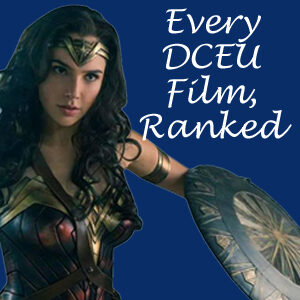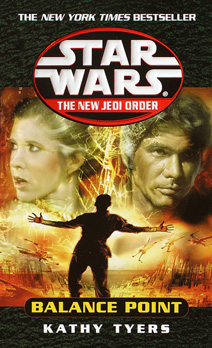In Kathy Tyers’ “Balance Point” (2000), the “New Jedi Order” saga continues to do a remarkable job of previewing George Lucas’ prequel themes and plot points a few years before they emerged on screen. I noted in my last review that James Luceno explored Jacen’s and Anakin’s different views on how to use the Force (paralleling Obi-Wan and Anakin) and Borsk Fey’lya’s political maneuvering against the Jedi (paralleling Palpatine’s schemes). “Balance Point,” the sixth book in the saga, ups the ante further with Jacen’s dream vision about the galaxy being at a tipping point (paralleling the Balance of the Force prophecy) and Warmaster Tsavong Lah’s bounty on the galaxy’s Jedi (paralleling Order 66).
I’m not a big fan of prophecies in literature, because I tend to find they manipulate characters rather than guiding them. In the case of the “Star Wars” prequels, the Balance of the Force prophecy only causes Yoda and Mace Windu to worry and make bad decisions. In the case of “Angel’s” Season 3 prophecy, Wesley makes a bad decision that puts the very person he is trying to protect, Connor, in danger. It is later revealed that the prophecy was put into place by a bad guy, not a good guy. Similarly, in “Star Wars,” we can never be sure that the Balance of the Force prophecy comes from a well-meaning prophet.
The same problem is prevalent in “Balance Point.” Jacen sees a vision of a Jedi perched on the disc of the galaxy, with his lightsaber pointing toward Coruscant, trying to maintain his balance. At first he thinks it’s Luke, but he (and the reader) begins to wonder if it’s Jacen himself (Tyers presents a clue by noting that both Luke and Jacen have a dimple in their chin). Combining the prophecy with his own beliefs, Jacen decides he should no longer use the Force, something that Luke thinks is odd and Jaina thinks is outright stupid and dangerous.
Frankly, I sided with Jaina. Although a philosophy of only killing in self-defense or defense of others is admirable, Jacen’s decision to not be a warrior at all seems selfish when he possesses special powers that can help people. Furthermore, while Kyp is certainly an example of someone who abuses his powers, Jacen is surrounded by role models who consistently use the Force for good, most notably his uncle Luke. Jacen’s vision – which he fears indicates his own turn to the Dark Side – somewhat tempers the idiocy of Jacen’s view, but not by much.
Before the book is even over, Tyers seriously challenges Jacen’s new philosophy with the trump card that can always be used when debating a pure pacifist: A scenario where the pacifist’s closest loved one’s life can be saved with violence. Jacen finally snaps out of his funk and rescues his mom from Tsavong Lah by using the Force to defeat his enemies. And, in fact, he does so without killing the warmaster; he merely costs Tsavong Lah his foot. And the Vong being who they are, he actually enjoys the pain of losing his foot and looks forward to getting a new one made by the Shapers.

If memory serves, upcoming “NJO” books will do a more nuanced job of exploring Jacen’s beliefs. “Balance Point” is OK at laying the groundwork, if a bit frustrating.
As with her only other “Star Wars” novel, “The Truce at Bakura,” Tyers’ writing is not as hook-laden as the saga’s elite authors. For example, I had forgotten that Droma – whose friendship and banter with Han Solo drove Luceno’s “Agents of Chaos” duology – is still present in “Balance Point.” It’s just that he’s a background character here, as refugees and the New Republic’s SELCORE workers (including all of the main heroes) go through various political, logistical and scientific struggles under domes on the industrially poisoned planet Duro before the Vong finally invade.
Even worse, Anakin seems tacked on to the story as if the editors asked Tyers to add him in a late draft. In one scene, Luke and Mara are conversing in a hotel room on one of Duro’s orbital cities, and Anakin just stands there without saying a word, which doesn’t fit with his headstrong characterization of previous books.
That having been said, Tyers – as she did in “Bakura” with her amazing scene between Leia and Vader’s ghost – occasionally surprises a reader with a daring character scene. Here, Jaina rips her mother – albeit to Mara, rather than to Leia herself – about not raising her kids, but rather shunting them off to Winter and putting them into hiding on Anoth. Whether Jaina has a point or not, it’s riveting to get Jaina’s point of view about her upbringing now that she’s old enough to reflect on it.
The hardcovers in the “NJO” saga (of which “Balance Point” is the second one, following “Vector Prime”) tend to not be the best books, but they do tend to drop the biggest pieces of information. “Balance Point” gives us Jacen’s vision and Tsavong Lah’s Order 66-style demand for the people of the galaxy to turn in all Jedi – particularly Jacen. Another key point is that Mara discovers she’s pregnant. While she and Luke playfully argue about the child’s gender, by book’s end she realizes it’s a boy. So “Balance Point” gives us the first chronological reference to Ben Skywalker.
The “NJO” saga continues to get good mileage out of the aftermath of the death of Chewbacca, which showed us that main characters are vulnerable. Jaina is at Duro, rather than piloting with Rogue Squadron, because she’s waiting for her vision to return after a dogfight against the Vong left her extravehicular. And by book’s end, Leia is the latest hero to be severely hurt, as she’s sedated in the Falcon’s med bay with serious injuries to her legs, paralleling Luke at the end of “The Empire Strikes Back.” A reader couldn’t be sure she’d make it to the next book.
Contrary to Disney’s assertion that these books were always just “Legends” tiding fans over until an “official” continuity could be devised, in 2000, fans were anxious about Leia’s fate and excited that the Skywalker family tree was continuing to grow. We believed this to be the official story; there was absolutely no reason to suspect otherwise. While the rewriting of the plot points of the post-“Return of the Jedi” “Star Wars” saga is frustrating, what really makes “The Force Awakens” seem like fan fiction to me is the assertion that wonderful characters like Jaina, Jacen, Anakin and Ben don’t exist. Even in a less-than-stellar entry like “Balance Point,” I’m invested in what happens to them and don’t see them as placeholder characters at all, but rather fully integrated members of the Solo and Skywalker families. They will always be the next generation of “Star Wars” to me.

